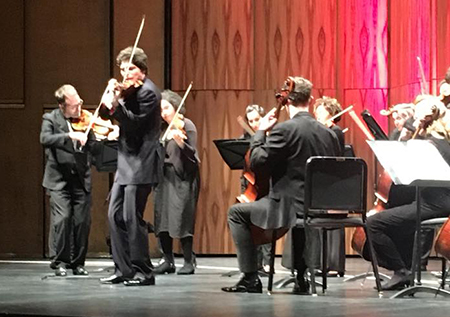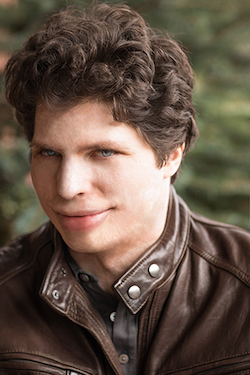by Daniel Hathaway

Irving Fine’s Serious Song: A Lament for String Orchestra might have seemed an odd choice to open the program, but it immediately demonstrated Orpheus’ powers of synchronicity. Labeled “an extended aria for string orchestra” by the composer, who wrote the piece in 1950 for the Louisville Orchestra, the elegiac work melds late-Romantic harmonies with objective modernism. Upper strings standing, the fifteen members of Orpheus kept closely in touch with each other, weaving and swaying to Fine’s expressive music.
Augustin Hadelich, the star of this program, shone in Joseph Haydn’s Concerto No. 1 in C. Dated 1765 and written for the young Italian concertmaster of the Esterházy orchestra, the concerto has one foot firmly planted in the Baroque period, while the other points in the direction of Viennese classicism. That implies a stylistic struggle, but the piece is a delightful synthesis of the two styles, and gives the soloist abundant opportunity to show his mettle.
Hadelich made easy work of the first movement’s double-stops and arpeggiations, brought expressive vocal qualities to the Italian serenade-like slow movement, and dashed stylishly through the contrasting solo passages of the finale. Hadelich was all smiles and charm as he interacted with his Orpheus colleagues, and they returned the favor handsomely.

The audience was rapt — and rapacious for more Hadelich. He gave them an extra piece as a parting gesture: a flawless performance of Paganini’s Caprice No. 19.
The second half of the program was devoted to Tchaikovsky’s Serenade for Strings, another piece that successfully melds two styles — in this case Mozartian orderliness combined with hyper-expressive Romantic melodies. Beginning with an imposing “Piece in the form of a Sonatina,” the Serenade moves on to a Viennese — or perhaps a Parisian — waltz, pausing for a reflective Elegy before ending with a finale crafted from Russian folk music.
Orpheus took a surprisingly aggressive approach to the Tchaikovsky, playing with outsized tone as though the Orchestra wanted to sound like a symphonic string section — or perhaps they were just trying to make a dent in the acoustic of E.J. Thomas Hall. This is where the intervention of a conductor might have helped steer the performance in a more genial direction. As a finale, it took some of the gloss off the evening, which might have ended more memorably with the Haydn concerto.
Published on ClevelandClassical.com April 5, 2018.
Click here for a printable copy of this article


